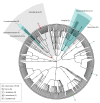Association of Oral Microbiome With Risk for Incident Head and Neck Squamous Cell Cancer
- PMID: 29327043
- PMCID: PMC5885828
- DOI: 10.1001/jamaoncol.2017.4777
Association of Oral Microbiome With Risk for Incident Head and Neck Squamous Cell Cancer
Abstract
Importance: Case-control studies show a possible relationship between oral bacteria and head and neck squamous cell cancer (HNSCC). Prospective studies are needed to examine the temporal relationship between oral microbiome and subsequent risk of HNSCC.
Objective: To prospectively examine associations between the oral microbiome and incident HNSCC.
Design, setting, and participants: This nested case-control study was carried out in 2 prospective cohort studies: the American Cancer Society Cancer Prevention Study II Nutrition Cohort (CPS-II) and the Prostate, Lung, Colorectal, and Ovarian Cancer Screening Trial (PLCO). Among 122 004 participants, 129 incident patient cases of HNSCC were identified during an average 3.9 years of follow-up. Two controls per patient case (n = 254) were selected through incidence density sampling, matched on age, sex, race/ethnicity, and time since mouthwash collection. All participants provided mouthwash samples and were cancer-free at baseline.
Exposures: Oral microbiome composition and specific bacterial abundances were determined through bacterial 16S rRNA gene sequencing. Overall oral microbiome composition and specific taxa abundances were compared for the case group and the control group, using PERMANOVA and negative binomial generalized linear models, respectively, controlling for age, sex, race, cohort, smoking, alcohol, and oral human papillomavirus-16 status. Taxa with a 2-sided false discovery rate (FDR)-adjusted P-value (q-value) <.10 were considered significant.
Main outcomes and measures: Incident HNSCC.
Results: The study included 58 patient cases from CPS-II (mean [SD] age, 71.0 [6.4] years; 16 [27.6%] women) and 71 patient cases from PLCO (mean [SD] age, 62.7 [4.8] years; 13 [18.3%] women). Two controls per patient case (n = 254) were selected through incidence density sampling, matched on age, sex, race/ethnicity, and time since mouthwash collection. Head and neck squamous cell cancer cases and controls were similar with respect to age, sex, and race. Patients in the case group were more often current tobacco smokers, tended to have greater alcohol consumption (among drinkers), and to be positive for oral carriage of papillomavirus-16. Overall microbiome composition was not associated with risk of HNSCC. Greater abundance of genera Corynebacterium (fold change [FC], 0.58; 95% confidence interval [CI], 0.41-0.80; q = .06) and Kingella (FC, 0.63; 95% CI, 0.46-0.86; q = .08) were associated with decreased risk of HNSCC, potentially owing to carcinogen metabolism capacity. These findings were consistent for both cohorts and by cohort follow-up time. The observed relationships tended to be stronger for larynx cancer and for individuals with a history of tobacco use.
Conclusions and relevance: This study demonstrates that greater oral abundance of commensal Corynebacterium and Kingella is associated with decreased risk of HNSCC, with potential implications for cancer prevention.
Conflict of interest statement
Figures


References
-
- IARC Cancer Fact Sheets: Estimated Incidence, Mortality And Prevalence (5 Years). Worldwide; Lyon, France. 2012.
-
- Nagy KN, Sonkodi I, Szöke I, Nagy E, Newman HN. The microflora associated with human oral carcinomas. Oral Oncol. 1998;34(4):304-308. - PubMed
MeSH terms
Substances
Grants and funding
LinkOut - more resources
Full Text Sources
Other Literature Sources
Medical

